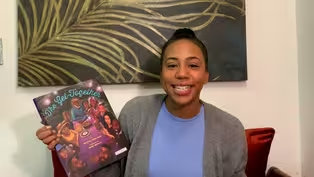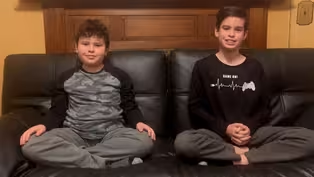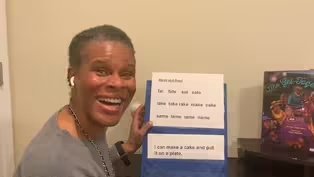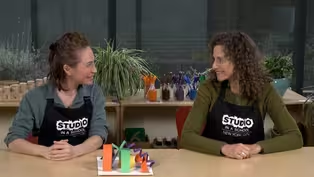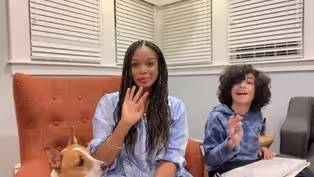
SORT OBJECTS AT HOME
Clip: 4/20/2023 | 8m 18sVideo has Audio Description, Closed Captions
Priya Chandrashaker and her daughter sort objects by attributes.
Priya Chandrashaker and her daughter show how to sort objects into groups based on attributes -- the characteristics of objects. She discusses how sorting objects can keep items like different kinds of clothing and stuffed animals organized at home.
See all videos with Audio DescriptionADProblems playing video? | Closed Captioning Feedback
Problems playing video? | Closed Captioning Feedback
Let's Learn is a local public television program presented by THIRTEEN PBS

SORT OBJECTS AT HOME
Clip: 4/20/2023 | 8m 18sVideo has Audio Description, Closed Captions
Priya Chandrashaker and her daughter show how to sort objects into groups based on attributes -- the characteristics of objects. She discusses how sorting objects can keep items like different kinds of clothing and stuffed animals organized at home.
See all videos with Audio DescriptionADProblems playing video? | Closed Captioning Feedback
How to Watch Let's Learn
Let's Learn is available to stream on pbs.org and the free PBS App, available on iPhone, Apple TV, Android TV, Android smartphones, Amazon Fire TV, Amazon Fire Tablet, Roku, Samsung Smart TV, and Vizio.
Providing Support for PBS.org
Learn Moreabout PBS online sponsorship[upbeat music] - What's wrong, Alina?
- Mommy, I can't find my stuffed animals.
- What's wrong?
Why?
- They're in a big mess.
- [Priya] Oh no, Alina, can I help you?
- Yes.
- Hmm.
- [Priya] Let's think about this.
What kinda stuffed animals do you have?
I noticed something about them.
What do you notice about this one?
- This one's very big.
Woo.
- Woo, let's see.
You're right.
Friends at home.
Do you see how big this one is?
What?
What about this one?
- This one little.
- It looks a little smaller.
Hmm.
Alina, I'm wondering something.
Maybe we can put your stuffed animals into some groups.
We can sort them and see where they go.
And maybe that'll help you find the one you're looking for.
What do you think?
- Let's do this.
- Did you know that sometimes we can learn about the world around us by looking at what we have and seeing if we can sort them.
- And it's good to sort things so you can find other stuff.
- [Priya] Friends at home we can learn more about where we live by looking at the objects in our own home.
There can be so many things in the places we live.
Sorting them is one way we can learn about all the things around us and help us stay organized.
Alina and I gathered some items that we found in our living room.
We have a collection of rocks here.
We can see how these rocks are the same and different.
For example, we might look at do they have the same color?
Are they the same size?
We can even think about what they feel like, to help us sort them.
That means put them together into different groups.
So Alina, could you help me sort them?
Let's see.
What do we notice about this rock?
[playful music] - [Alina] I notice that this rock is very bumpy.
[playful music continues] And I notice that this rock is very smooth because it doesn't have any bumps on it.
So let's put them in each piles and then we'll find the one we need.
- [Priya] Awesome.
Let's look at some more rocks and let's decide together.
Would they belong in the bumpy group or in the smooth group?
- [Alina] Let's get started.
So the first, the second rock is we have two of these rocks.
[playful music continues] This one, this one's a little smooth, but it's also bumpy.
- [Priya] Feels a little rough to me too.
It has some like sharp edges on it, right?
- [Alina] But let's see, there's more bumpy and less smooth.
So we'll put it on the pile with the bumpy side.
- [Priya] The rough side.
That's right.
- [Alina] Okay, the next one.
This one feels smooth and, and it doesn't feel heavy.
So this one should go in the smooth pile.
Next one, we have this rock.
This rock feels rough.
[playful music continues] So I think it should go in the rough pile.
- [Priya] Hmm.
I noticed something Alina.
- What?
All of these rocks look rough to me.
When I touch them there's some bumps on them or some sharp parts to it.
But when I touch these rocks, they're all very smooth.
So that means we sorted our rocks by how they feel when we touch them.
These are bumpy, these are smooth.
There's one more rock we're gonna look at here.
Can you help me with this one?
- [Alina] Yes.
So this one is very bumpy, but it also is a little smooth, but it should go on the bumpy side.
- Awesome job.
So friends at home, we were able to sort our rocks into two groups, our smooth rocks and our rough and bumpy rocks.
So Alina, we were able to find your stuffed animal, your favorite one, 'cause we sorted them into groups.
We did 'em into groups of big things, medium sized things, and small things.
Did that help you find your favorite stuffy?
- Yes.
- All right.
So friends at home, we noticed something.
We noticed that we can sort things all around us.
Sometimes at home we might find ourselves in a big mess and we can think about how to sort them into groups by looking at how they're the same or different.
And that might help us when we're in a big mess next time.
What do you think, Alina?
- Let's do it.
- All right.
Friends at home, we're gonna play a fun game.
We're gonna play, guess how I sorted?
All my rocks are mixed up.
I'm gonna sort them based on something that's the same about some of these rocks.
And after I'm gonna have Alina, guess what my rule is?
How did I sort them?
Remember there's different ways we can sort, Alina.
We can sort by shape, we can sort by how they feel.
We can also sort by the color.
All right?
Pay attention to how I sort and let's see if you can guess how I sort it.
Okay, Alina, what do you notice?
- [Alina] I noticed that these are all white and these aren't.
- [Priya] Excellent job.
You're right!
We sorted by color.
All these rocks have white in them.
They're like a light color.
All of these rocks have a lot more color in them.
Great job, Alina.
You guessed how I sorted.
Could you count how many are in the group that are white?
- [Alina] 1, 2, 3.
There are three white rocks.
- [Priya] Can you count how many are in our other group?
- [Alina] 1, 2, 3, 4, 5, 6.
There are six rainbow rocks.
Color.
- Excellent job.
So today we were able to sort our rocks by how they feel when they were all rough and by the rocks that were smooth.
We also were able to sort it by color, the rocks that were white or have white in them, and the rocks that had more color in them.
Friends at home, did you see how we learned more about the world around us, especially in our home today?
We found some objects and we were able to sort them and organize them based on the things that we've noticed were the same and different.
You might notice in your home there are places that items are organized and sorted.
For example, in your bedroom, hmm, your clothes, they might be sorted by pants, shirts, and socks.
You might notice that they're all put into different drawers or maybe in your kitchen.
If you ever need to go get a fork or a spoon, you'll notice that they're all sorted.
They're sorted by knives, forks, and spoons.
So next time friends, when you might be in a little bit of a mess at home, try sorting things out.
Try noticing what's the same and different and putting them into different piles or organizing them.
And maybe that'll help you out just like it did for Alina today.
Thanks for joining us today, friends.
Bye.
BUILD 3D STRUCTURES WITH BLUEPRINTS
Video has Audio Description, Closed Captions
Clip: 4/20/2023 | 9m 13s | Cassondra Easterling and her children build 3D structures with blueprints. (9m 13s)
Video has Audio Description, Closed Captions
Clip: 4/20/2023 | 8m 11s | Shana Davis reads THE GET-TOGETHER by Christine Taylor-Butler. (8m 11s)
JOHN AND JORDAN DEEP BREATHE TO RELAX!
Video has Audio Description, Closed Captions
Clip: 4/20/2023 | 47s | John and Jordan deep breathe to relax. (47s)
Video has Audio Description, Closed Captions
Clip: 4/20/2023 | 11m 26s | Isabel Simmons teaches children about the long a sound when an e is at the end of words. (11m 26s)
Video has Audio Description, Closed Captions
Clip: 4/20/2023 | 9m 18s | Katherine Huala from Studio in a School makes a paper playground sculpture. (9m 18s)
Video has Audio Description, Closed Captions
Clip: 4/20/2023 | 9m 12s | Maria Begg-Roberson and her son discuss places in their neighborhood that meet people’s ne (9m 12s)
Providing Support for PBS.org
Learn Moreabout PBS online sponsorshipSupport for PBS provided by:
Let's Learn is a local public television program presented by THIRTEEN PBS

